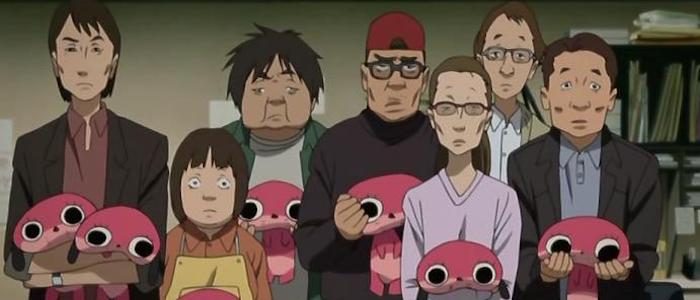
(Welcome to Ani-time Ani-where, a regular column dedicated to helping the uninitiated understand and appreciate the world of anime.)
It’s not hyperbole to say it feels like the world is on fire, and it’s very tempting to want to get away from it all and look for some escapism. Of course, leave it to the late, great Satoshi Kon to find a way to masterfully teach us about the dangers of escapism and the importance of confronting trauma and reality, no matter how hard it is, in his first — and only — TV show.
Paranoia Agent begins with a woman walking home alone at night, when she is attacked by what appears to be a young boy wielding a golden baseball bat and riding around on in-like skates. Soon enough, more attacks take place, and the legend of the “Shonen Bat” (or “Lil’ Slugger” in the dub) grows, and the police are overwhelmed.
Like Twin Peaks, this show is initially about a simple mystery — who is Lil’ Slugger? Why did he attack? What’s the connection between the attacks? And much like that classic David Lynch show, Paranoia Agent quickly evolves into something more, an exploration of escapism and trauma through surrealism, as Satoshi Kon blends the line between reality and fiction in a terrifyingly precinct and surprisingly funny thriller.
What Makes It Great
I mentioned in my Wonder Egg Priority article how much that anime resembled a Satoshi Kon production, but here’s an actual Satoshi Kon series. From the opening sequence alone, Paranoia Agent intercuts character drama with surreal imagery that makes you question just what the hell is really going on and whether you can trust what’s on the screen. This is, of course, a key part of the experience of watching a Kon movie, and the filmmaker did talk about how much of the show was him trying to recycle many unused ideas for stories he couldn’t fit into his feature film work.
Paranoia Agent is an anthology, and each episode tells a separate story focusing on a different character that only tangentially relates to the rest. The genius of the show is the way it jumps from comedy to horror, and fantasy to drama. There are episodes with washed-out lighting and hard cuts to create a constant sense of unease, followed by a bizarre yet cute scene of a talking Hello Kitty-like toy. That’s sandwiched between an episode about a guy stealing from old ladies to pay the yakuza, and an episode about us finding out how much of a creep he is. We also get a goofy fantasy adventure where a kid tells detectives he attacked a bunch of people to save them from Dragon Quest-style monsters.
Then there’s a trio of standalone episodes that are not really about the show, but about the general idea of paranoia and other barely-related topics, like a very, very bleak comedy about internet friends failing to commit group suicide, a group of women gossiping about Lil’ Slugger, and an incredibly prescient episode about the production of an anime show. Overproduction and bad working conditions were not new in the anime industry, but they certainly weren’t nearly as widely discussed as they are today. Over a decade before Keep Your Hands Off Eizouken taught us about the struggle between the artistic and economical side of anime, Satoshi Kon turned that idea into a bleak yet poignant black comedy where an animator dies at their desk, but their supervisor doesn’t notice because everyone sleeps at their desk all the time.
What It Adds to the Conversation
It becomes clear very early on that those who get attacked by Lil’ Slugger were emotionally cornered, and they are using the attack as a scapegoat for their own problems. This creates a situation where mass hysteria and fear of being attacked is played in contrast to the actual victims seemingly feeling relieved by being hit with a baseball hat. The more people get attacked, the more it seems like Lil’ Slugger may be more than just a person, but a social conceit like Candyman.
Paranoia Agent was released right in-between Tokyo Godfathers and Paprika, but it feels mostly like a spiritual sequel to Kon’s best-known film, Perfect Blue, in how they deal with social anxieties by blending reality with fiction to make the audience question just what they’re actually watching. Already in its opening sequence, Paranoia Agent uses surreal imagery to convey its core theme of people doing their best to avoid confronting their trauma. The opening features all the supporting characters smiling and laughing as the world burns behind them. Every character on the show is trying to escape from something, to avoid confronting something big in their lives, and so they turn to vilify an external enemy or find comfort in escapist entertainment like a video game, or an anime. The show is not subtle about its message, but it’s incredibly effective in portraying the hardship, and also the importance, of having to take responsibility for your own actions in order to heal.
Why Non-Anime Fans Should Check It Out
Paranoia Agent is a complex, thrilling, hilarious, and at times even terrifying show that comments on everything from Japanese society’s response to their role in WWII to “kawaii culture” to the internet and social media. This show is a perfect companion to Perfect Blue and even Serial Experiments Lain, in the way it makes you doubt the reality of what you’re watching. If you’ve never seen a Satoshi Kon production, these 13 episodes are a perfect encapsulation of what made him such a master of anime filmmaking.
Watch this if you like: Serial Experiments Lain, Perfect Blue, Erased, Black Swan
***
Paranoia Agent is streaming on Funimation.
The post ‘Paranoia Agent’ is a Funny and Terrifying Anime About Anxiety and Escapism appeared first on /Film.
0 Comments